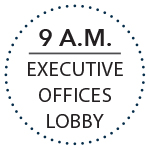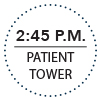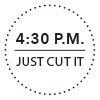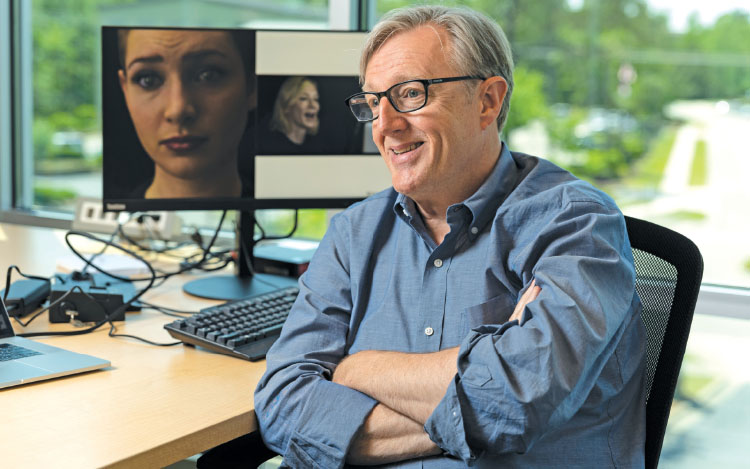
It’s a typical Monday morning meeting with announcements and scheduling – until people start getting choked up.
John Gizdic, president and CEO of New Hanover Regional Medical Center, pulls up an email from the son of a patient who underwent open heart surgery but ultimately passed away after weeks in the ICU. The son had written to share appreciation for specific staff members, strangers who all of a sudden became part of the family’s daily sphere.
“Jeff, a nurse manager, checked on my dad every day of the 40 he spent on the ninth floor, even when he wasn’t his assigned patient,” Gizdic reads to the dozen or so hospital vice presidents and executives gathered at their regular huddle meeting.
“John Russell, ICU nurse, was … there when dad’s trajectory turned irrevocably for the worse. He maintained such professionalism while providing unrivaled compassion during the most difficult hours of our lives. His care for my father and family will be emblazoned in my memory for many years to come.”
When it comes to the business of health care, there are few other industries that directly impact people on such a personal level – in good and bad situations – and few others that have undergone such rapid changes in recent years.
For NHRMC, whose patient levels have ballooned, those changes are constant.
As its footprint has grown with the area’s growing population and additional services, so has its revenue.
Last year, NHRMC’s operating revenue surpassed $1.1 billion and is forecast for more than $1.2 billion this fiscal year, which runs through the end of September. Those figures include its physician group and accountable care organization – entire operations that didn’t exist a decade ago.
Without the separate physician group and ACO factored in, the hospital’s annual operating revenue crossed the $1 billion mark last year for the first time, up 64% from 2011, according to its financial reports.
Earlier this year, Gizdic was preparing materials one evening for an upcoming executive retreat. He was trying to find a way to put into context that the hospital was now a billion-dollar operation.
So he turned to Google and started looking up companies that were household names with similar revenue results.
The Wendy’s company, holding company for the fast-food chain, came up, as did action camera maker GoPro.
“Last year they just crossed a billion dollars in revenue. So we’re bigger than GoPro,” Gizdic said. “If we were not a public, not-for-profit, we would be a Fortune 1000 company. And when you look at the Fortune 1000, which I did, it’s staggering to put New Hanover Regional Medical Center in perspective.”
The hospital, however, is not a private entity, which makes a difference in its bottom line.
While NHRMC doesn’t use local tax dollars, as a not-for-profit organization it’s not subject to paying income taxes.
As revenue has grown so have expenses, leaving the organization with an operating margin of 5.47% last year.
In recent years that margin has ranged from 6-9.5%.
With the excess funds, said Ed Ollie, NHRMC’s chief financial officer, the hospital uses money for routine capital replacement – an average of $60 million a year.
“What is not spent is placed into cash reserves for future capital and/or equipment additions or replacement,” Ollie said.
Money also is socked away to add to its days of cash on hand, or the number of days it could continue to fund operations after a catastrophic event with no income coming in. That reserves target goes up each year as daily expenses increase, and Standard & Poor’s would like to see the hospital sit on 300 days of cash on hand as part of its credit rating process.
“In round numbers, it roughly costs us about $3 million a day to run our organization,” Ollie said.
The recent growth isn’t lost on Gizdic, who has been with NHRMC for 15 years, first as a vice president and now as head of what is far and away the largest employer in Southeastern North Carolina.
“It used to be easier to get around and see everybody when it was 3,500 employees, and we were basically on one campus,” said Gizdic, who began moving into the head role three years ago as former CEO Jack Barto transitioned into retirement.
In those 15 years, the employee count has doubled to 7,000. And NHRMC’s presence has grown to dozens of locations dotted throughout the region.
Construction, which has taken place pretty much nonstop for years, has resulted in 2 million square feet of hospital space, most of it at the continually expanding South 17th Street campus. That total doesn’t include the more than 30 physician group locations now in NHRMC’s network.
Even the name has slowly morphed from New Hanover Regional Medical Center – the hospital – to NHRMC – the health system.
“If I go back to 2004 when I came here, this was sort of a sleepy community hospital,” said Ollie, Barto’s first hire when he arrived. “Obviously, it didn’t have a women’s and children’s hospital. We have renovated the (patient) tower. We’ve added on the outpatient surgery and all that … We didn’t really have the number of locations that we have now around the community. So it was just a hospital, and it’s transitioned from that to a health care system now, anchored from what was a community-based hospital.”
New Hanover Regional is the ninth-largest hospital in North Carolina and the largest county-owned public hospital in the state.
Once its new orthopedic hospital opens – construction for the three-floor tower is going on now in the back of the main campus – New Hanover Regional will have a total of 800 licensed beds.
Its major expenses come from medical supplies and salaries.
Last fiscal year, personnel costs exceeded $590 million, and supply costs topped $261 million.
“Maintaining your staff and recruiting good staff is the hardest thing in health care because there’s more and more demand, and people keep raising wages,” Ollie said. “And so if you’re not going to continue to raise your wage, you can’t recruit.”
One way the health system has tried to contain costs over the years is through an organizational-wide devotion to the lean process.
Attention to lean – finding ways to streamline waste or inefficiencies to cut costs – started in the past decade under Barto and is now pretty much a part of NHRMC’s DNA, with ideas coming from all employee levels.
It’s to the point that health systems from other states, or in one case Scotland, pay for consulting site visits to learn from NHRMC’s model.
“In the past seven or eight years, we have documented savings of over $200 million in real hard dollar cost savings as a result of that process,” Gizdic said about implementing staffers’ lean ideas. “And not a single employee has been laid off to achieve that.”
 Hospitalist physician Charmain Lewis visits patient Dale Odom at NHRMC's main facility. (Photo by Michael Cline Spencer)
Hospitalist physician Charmain Lewis visits patient Dale Odom at NHRMC's main facility. (Photo by Michael Cline Spencer)

Dale Odom had been feeling sick to his stomach for days.
Not sure what the problem was, the Ogdon resident saw his doctor, who as Odom’s symptoms got worse, recommended he go to the hospital’s ED-North, a standalone emergency department that opened in 2015 to serve entire company that we didn’t have as part of our organization.”
NHRMC is not the only health care organization to add physician groups. Novant Health has done so in Brunswick County as have other systems throughout the country.
The adoption of electronic health record systems, incentivized by the federal government, helped accelerate the consolidation of doctor offices as the cost for electronic records became a burden for some individual practices.
Today, while there are a few independent practices that remain in the market, NHRMC’s group is the largest, spanning primary care to cardiology to OB/GYN. It is followed up in size by Wilmington Health.
While the number of individual providers continues to grow for patients, their choices for which health company to pick have decreased.
At the hospital, NHRMC holds 78.7% of the market share when it comes to inpatient care for the tri-county area, as of 2017.
With such a dominant presence, the onus for continuing to innovate and improve service falls on the organization instead of competition.
“So in a Raleigh or a Charlotte, you’re going to have multiple hospitals and multiple health systems competing for that growth,” Gizdic said. “I actually look at our situation as a very positive situation, not selfishly because I don’t have any competition as one would think. I look at it in the way of since we’re able to focus, we’re able to grow and meet the community’s needs with specific expertise.”
As an example, Gizdic said, the hospital would not have two pediatric surgeons on staff if it had more competition. The volume wouldn’t sustain it.
“Think of the pediatric subspecialties we now have in this community: pediatric endocrinology, pediatric neurology, pediatric GI. We have multiple pediatric subspecialists that we didn’t have a decade ago because of that focus and being able to support that expertise. There would not be enough critical mass or volume if that was split over two or three different organizations,” he said, adding other examples such as neurology and stroke specialists. “
And so I think there are multiple ways to look at being or having a monopoly,” Gizdic said. “I think we’ve used it for good and not evil.”
When you consider the entire seven-county region, 45% of inpatient business came to New Hanover Regional about a decade ago. Today, that’s closer to 55%, Gizdic said.
“The secondary service area, which would be Onslow, Duplin, Bladen and Columbus counties is, I would say proportionally, where we’ve seen the most growth,” he said. “A decade ago, or a little more than a decade ago, we didn’t have a partnership with Dosher hospital or Columbus hospital. We do now and have actual relationships and affiliations with those organizations so that we can try to work with them to keep what’s appropriate local right there in their community and just transfer the next level of care, the higher level of care, that we’re capable of providing.”
In the past, Novant Health was primed to make a move into New Hanover County. It received approval from state regulators in 2007 to open a surgical center in Autumn Hall.
The recession changed those plans, and they decided to focus on services in Brunswick, said Shelbourn Stevens, the president of Novant Health Brunswick Medical Center.
Earlier this year, the two hospitals entered an agreement for NHRMC to station its third AirLink patient transport helicopter at the Novant hospital in Bolivia.
Strategic partnerships are one way hospitals now are looking to expand, Stevens said. As an example, he pointed out the difficulty Novant had in recruiting cardiologists, who are in short supply, to Brunswick County.
“So it just made sense to reach out to Cape Fear Heart (Associates, part of the NHRMC Physician Group) and say, ‘You need a presence in the county. We’re going to send them to you. So they expanded and hired more providers who cover Brunswick County as their main office, and then on weekends and after hours, they have a presence here,” Stevens said. “And you know, who’s to say down the road? I might call John and say, ‘I can’t get this specialty x, and do you want to a partner with us here to cover that? Because from a New Hanover standpoint, if it’s a patient that we can keep here locally, they want that because they’re full.”
From an inpatient setting, the hospital nears capacity every day.
“How do we make sure it’s the right place for them to get care and really focus on growing our ambulatory and outpatient presence as well as our primary care presence?” Gizdic said. “Last year was the first year that outpatient revenue exceeded inpatient revenue for our organization. That was a turning point.”
In 2014, the hospital’s daily census, or number of patients admitted, averaged 519. That’s increased 17 percent to a forecast average of 607 people a day this year.
One way to manage patient volumes is to keep people out of the hospital to begin with, something NHRMC’s working on.
 Joe Conway (right), NHRMC's director of health equity and human experience, talks with barber Frank Walker and customer Joshua Jones at Just Cut It barbershop on Castle Street. (Photo by Megan Deitz)
Joe Conway (right), NHRMC's director of health equity and human experience, talks with barber Frank Walker and customer Joshua Jones at Just Cut It barbershop on Castle Street. (Photo by Megan Deitz)

Joe Conway stops into Just Cut It on Castle Street, checking in with barber Frank Walker and owner Cedron Emerson.
It was here in November 2017 that the hospital tried something new. In an effort to move preventive health into the community, off-campus health workers visited the barbershop with flu shots.
“And then we did blood pressure, and we had our pharmacists that were involved, our nurses were involved. That was the first time we’d actually reached out in that particular way,” said Conway, who has worked at NHRMC for more than a decade but in 2017 became its first director of health equity and human experience.
So they repeated the barbershop visits. Then they added Dancin’ in the Park events on Saturdays at Portia Hines Park on North 10th Street, sending out fitness dance instructors and health workers for screenings.
“You’re talking health and wellness. Well, we just can’t say this is what we want to do, we’ve got to actually do something,” Conway said. “That took off.”
And now his department facilitates a task force to try and get a grocery store open on the Northside to address the area’s food desert, with the idea that it could become a community-run co-op.
He defines the term health equity as “assuring support to individuals in achieving their highest level of health.”
“What is the best possible health for you?” Conway said. “If you’re coming in uninsured, you have Medicaid, or you’re underinsured, you don’t make more than $23,000 a year, you live in a particular zip code – which can say probably more about your health status than even your race – when you’re looking at all of those things, you got to be very, very careful in the approach.”
The efforts tie into to NHRMC’s mission statement that Gizdic updated when he became CEO: “Leading our community to outstanding health.”
A healthier community would mean fewer admitted patients, fewer doctor visits – less business if you’re in the business of healing, right?
But with the industry shift toward bundled payments, which are reimbursements for caring for the patient overall instead of episodic care, the incentives back the community outreach efforts as well.
“We can be a model region for improving health, which ultimately lowers the dollar for spending on health care,” Gizdic said. “And as a community, every dollar we spend on health care is a dollar we’re not spending somewhere else in our community and in our economy.”
The amount of patient revenue NHRMC doesn’t collect because of unpaid bills and charity care rose to more than $180 million last year, including $74.4 million for charity care.
There are nearly 18,500 Medicare patients enrolled in NHRMC’s accountable care organization, a voluntary program the health system has signed up for with the federal government to provide coordinated care for enrollees in exchange for potentially sharing cost savings.
The ACO spent about $9,600 on health care costs per Medicare patient in the program in 2017, according to the most recent performance report. Wilmington Health also runs an ACO, with 13,500 enrollees and spent about $8,700 per person.
Both programs have received national rankings for quality of various services and screenings.
 Chris Hillier, NHRMC's executive director for innovation, discusses a pilot project for an artificial intelligence-based cardiac coach to help patients around-the-clock. (Photo by Michael Cline Spencer)
Chris Hillier, NHRMC's executive director for innovation, discusses a pilot project for an artificial intelligence-based cardiac coach to help patients around-the-clock. (Photo by Michael Cline Spencer)

Besides getting out into the community more, another recent focus for NHRMC is on the next phase of health technology.
Seven years ago, its biggest tech project was adopting a multi-million dollar system for electronic health records and convincing doctors to stop hand writing patient charts.
Today, Chris Hillier, who was hired last year as NHRMC’s first executive director for innovation, sits at tekMountain organizing the final pitch event from a group of budding health entrepreneurs.
Last month NHRMC finished up its first cohort for Speed of Health, a 10-week program to develop ideas into potential business opportunities. Participants this round came from the hospital’s workforce but also included a team from the New Hanover County health department.
In his new role, Hillier is tasked with helping to make innovation part of the hospital’s company culture, so that employees throughout the health system start thinking about it.
He also is looking into projects the hospital might take on to become more competitive digitally.
For example, from his office at tekMountain, Hillier demonstrates a digital human who could one day soon interact with local cardiac patients.
Under the working name of Hanna (a play on Hanover), she would be available online and through smartphones or other devices around the clock for patients’ questions. The avatar would be built on artificial intelligence, and its language programmed from a blank slate to reflect speech patterns specifically for this area.
“It will be nonjudgmental. It will be anonymous,” Hillier said, “and they’ll be able to ask this cardiac coach questions about their therapy, make appointments and discuss concerns but in true conversation, real-time conversation.”
Hillier, who comes from a tech entrepreneurship background and worked on health care innovation for Blue Cross and Blue Shield of Florida, is collaborating on the cardiac coach idea with the Australia-based Centre for Digital Business to potentially license the technology.
Already, NHRMC has equipped some patient rooms with Amazon Alexa-enabled smart speakers and is about to use robot mapping throughout its facilities for an app to help people navigate.
“We’re looking at how do we use cryptocurrency as it relates to health and incentives and changing behavior,” Gizdic added. “How do we really embrace different ways of thinking that our industry hasn’t necessarily been the most progressive on?”
The push is about more than just having cool new toys to play with or supporting startups for employee morale.
There’s real pressure on the industry from outside companies, from tech startups and giants to national retailers, to disrupt how patients engage with health care by solving some of the system’s clunkier problems. Those include consumer access and cost transparency.
“Health care knows that they have to move from fee-for-service to valuebased, and every other industry on the planet is moving in that direction. Health care is actually last,” Hillier said. “If you look at banking, banking is the most conservative industry out there historically, but yet, even banking has moved into a consumer-friendly approach to everything, and they’re very risk-averse.”
The reason health care is “last to the table” in this area, Hillier said, is because the industry is so complicated.
“The complexity of health care is a real challenge, but the consumer doesn’t care,” he said.
Amazon is exploring a range of health-care projects, partnering with companies on activities from selling consumer-targeted medical devices to developing a cloud-based drug discovery platform.
Amazon’s joint venture with J.P. Morgan and Berkshire Hathaway, dubbed Haven, formed to tackle the issue of rising health care costs.
“The complexity of health care makes it almost impossible for anyone to understand how much they’re paying and for what, so that’s another pressure,” Hillier said.
The U.S. Senate is expected to discuss a wide-ranging bill addressing health care costs, price transparency and insurers’ contracts with hospitals.
Legislation changes, technology shifts and aging populations are all issues that will continue to shape how NHRMC does business in the future. Because of its size, how it manages those changes will play a vital role in the area’s economic health.
According to a 2012 study, the most recent one done, NHRMC accounted for 11.1% of the economic activity in the tricounty area. That most certainly has gone up since.
“When you think about investment, which is exactly what I call it, the past decade or so, give or take a year, we’ve invested over a billion dollars in facilities, technology, equipment,” Gizdic said.
With the area’s population expected to continue to grow in the years ahead, the need for health care services won’t slow down anytime soon.
“What has made our organization successful over the past decade is not necessarily what’s going to make us successful over the next decade. And what got us here isn’t going to get us to where we need to be,” Gizdic said. “That is really kind of a cultural shift that we need to make as an organization. So I think, over the next decade, it is really transforming our organization and what our organization looks like to really meet the health needs of our community.”





 Joe Conway stops into Just Cut It on Castle Street, checking in with barber Frank Walker and owner Cedron Emerson.
Joe Conway stops into Just Cut It on Castle Street, checking in with barber Frank Walker and owner Cedron Emerson.



